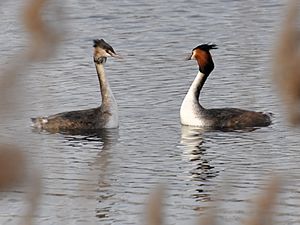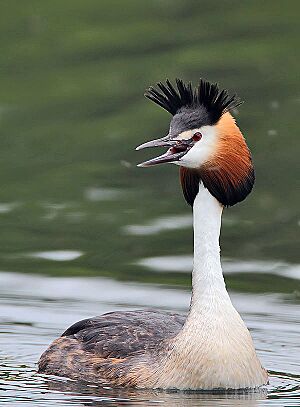Courtship in animals facts for kids
Animals do special things to find a partner and have babies. This is called courtship. It's like a show where an animal, usually the male, tries to impress a female. They want to show off their best qualities!
These shows can include many things. Animals might do special dances or make unique sounds. They might also show off their beauty or strength. This helps the male present his best traits to a female. Females then choose the male they like best. Since babies get half their genes from each parent, females pick males with good traits. This helps make sure their babies are strong and healthy. Sometimes, males even compete to show who is the best choice.
Many animals use more than one way to impress a mate. They might combine different types of signals.
Contents
How Males Attract Mates
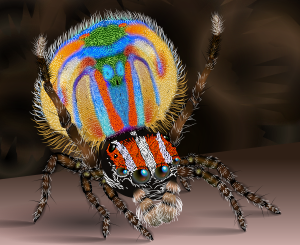
Males often perform special movements to attract females. For example, the male six-plumed bird-of-paradise does a "ballerina dance." He also has unique feathers that help impress the female. Another example is the Drosophila subobscura fly. The male shows off by moving his wings in special patterns and quickly stepping sideways.
Some males use both sight and sound to attract a mate. Anna's hummingbird and Calliope hummingbird males do two types of shows. They combine visual displays with special sounds. In one display, the male hovers in front of the female. He shows off his bright throat feathers and moves side to side. His wings make a buzzing sound. In another display, the male flies high into the air. Then he dives down fast. As he flies over the female, he spreads his tail feathers. These feathers flutter and make a short buzzing sound.
Fiddler crab males have one very large claw. This claw can be a third or even half of their body weight! They use this big claw to fight other males for their homes. But they also use it to attract females. They wave the large claw in a special way to get a female's attention.
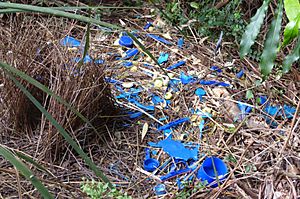
Some animals build and decorate special structures to attract females. The satin bowerbird of Australia is a great example. Males build "bowers," which are like small, decorated nests. They decorate these bowers with bright, colorful objects, usually blue. These decorations attract and excite visiting females. Males with the most decorations usually have the most success in finding a mate.
How Females Attract Mates
It's less common for females to put on big courtship shows. Males usually do most of the impressing. But sometimes, males are in short supply. This can happen if finding a mate takes a lot of energy for males. For example, they might need to find special gifts for the female. Or they might perform long, tiring dances. These efforts can even make it harder for males to survive.
In pipefish, females use a temporary striped pattern. This pattern helps them attract males. It also helps them scare away other female rivals. So, the female's special look helps her find a mate and keep other females away.
When Both Partners Display
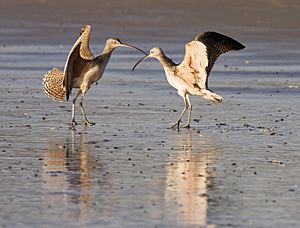
Often, both males and females perform courtship displays together. They might do synchronized movements or respond to each other. For example, male and female crested auklets cackle at each other. This vocal display helps them strengthen their bond.
Sometimes, males even work together to attract females. This happens with long-tailed manakins. Small groups of males, often brothers, work together to impress females. They also try to keep other males away. In many cases, only one male in the group will actually mate. This is usually the strongest male.
Special Body Parts for Attraction
Animals often have special body parts that make them more attractive. These are called sexual ornaments. They can show that an animal has good genes and is very healthy. For example, if a male has bright, fancy feathers, it might mean he is strong.
Sometimes, females will invest more in their babies if the male is very impressive. Female canaries, for instance, lay larger eggs. They also lay eggs with more nutrients if the male sings a super-normal song. This means the male's song makes the female think he is a great partner.
Long Courtship Periods
Before mating, many animals have a courtship period. This is when they choose their partners. This period is usually short, from 15 minutes to a few days. But some animals have a very long courtship. It can last as long as two months!
The emperor penguin is one example. Their courtship can last up to two months. This is the longest courtship of any Arctic seabird. It takes up 16% of their total breeding time. Their close relatives, the king penguins, only spend 3% of their breeding cycle on courtship.
How the Environment Affects Courtship
Things like temperature, daylight hours, and food can affect courtship. These environmental factors influence when and how well animals perform their displays.
For example, guppy fish are affected by light. Male guppies look for places where their colorful patterns are most visible. They spend more time in these bright areas to attract mates.
For emperor penguins, food availability is key. More food means they can get strong faster after winter. This allows them to return to their breeding grounds earlier. Coming back early increases their chances of finding a mate.
The color of the fungus also affects Hirtodrosophila mycetophaga flies. These flies mate on bracket fungi. They choose lighter-colored fungi. This makes their courtship displays easier for the opposite sex to see.
Related pages
Images for kids
-
God Speed by English artist Edmund Leighton, 1900: depicting an armored knight departing for war and leaving behind his wife/lover.
-
"Southern Courtship" by American painter Eastman Johnson (1824–1906).
-
Courtship of green turtles


